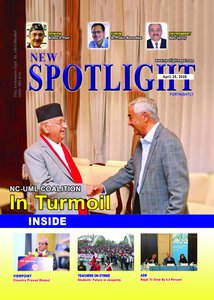In 2003, British writer Robert Macfarlane published “Mountains of the Mind”, a searing exploration of humanity’s obsession with summits. Two decades later, as Nepal’s Himalayas buckle under climate collapse, spiritual commodification, and the weight of Western wanderlust, the book reads less like history and more like prophecy. Macfarlane’s dissection of peak paradoxes—how mountains became symbols of purity and conquest—resonates uncannily in a nation where deities and debris now share the same slopes.
From Romanticism to Reality: The West’s Mountain Myth
Macfarlane traced Europe’s metamorphosis from fearing alpine “wastelands” to romanticising them as temples of transcendence. In the 18th century, poets like Wordsworth reframed crags as sanctuaries for spiritual communion; by the 20th century, George Mallory’s doomed Everest quest (“because it’s there”) epitomised the West’s hunger for conquest. Yet Nepal’s peaks, long revered as living gods, defied such simplification.
“Foreigners see summits; we see mothers,” says Kami Rita Sherpa, who has summited Everest 28 times since the 1990s. “Chomolungma [Everest] isn’t inert—she gives us water, warnings, and weather.” When “Mountains of the Mind” debuted, Sherpa rituals like puja ceremonies—offerings to mountain spirits—were often reduced to exotic photo ops for climbers. Today, as overcrowding and trash plague Everest, those rituals feel like urgent pleas for respect.
2003’s Warnings, 2023’s Crises
Macfarlane’s elegy for vanishing glaciers and exploited landscapes anticipated Nepal’s current reckoning. In 2003, the Khumbu Glacier was already retreating, exposing decades of expedition debris—rusted oxygen tanks, frayed ropes, frozen waste. Two decades later, the glacier has shrunk by two miles, and glacial lakes threaten villages below.
“Macfarlane wrote about ‘loss haunting the sublime,’” says Nima Doma Sherpa of the Sagarmatha Pollution Control Committee. “Now, loss isn’t a shadow—it’s a flood.” Record heatwaves, erratic monsoons, and vanishing ice have turned Nepal’s peaks into climate crisis ground zero. The 2021 IPCC report singled out the Himalayas as a hotspot for accelerated warming—a crisis Macfarlane’s generation could scarcely imagine.
Sherpas: From Silent Guides to Storytellers
“Mountains of the Mind” centred Western adventurers, reflecting early 2000s mountaineering literature’s blind spots. Sherpas—then relegated to “support staff”—rarely shaped narratives. Today, their voices are rewriting Himalayan history.
Ang Tshering Sherpa, whose family has guided expeditions since the 1950s, recalls the era: “Foreigners called us ‘brave,’ but never asked why we climb.” Now, Sherpa-led initiatives like the Himalayan Database document their contributions, while writers like Prajwal Parajuly (The Gurkha’s Daughter) challenge colonial tropes. Even Hollywood’s “Everest” (2015) faced backlash for sidelining Sherpas—a shift Macfarlane’s book foreshadowed but didn’t address.
Sacred Summits in a Secular Age
Macfarlane’s climbers sought “purity” in thin air, but Nepal’s peaks have always embodied sacred reciprocity. Machapuchare, the fishtailed Annapurna peak, remains forbidden to climbers—a pact between humans and gods. Everest’s Base Camp, however, teems with Instagram influencers and espresso bars, its sanctity diluted by commercialisation.
“The West’s ‘sublime’ is our daily life,” says Phurba Tenzing Sherpa, a Lama from Dolpo. “When foreigners fetishise ‘pristine’ peaks, they erase our struggles: landslides, migration, poverty.”
The New Pioneers: Climate Warriors and Women
Macfarlane’s male-centric tales contrast with Nepal’s modern trailblazers. Pasang Lhamu Sherpa, the first Nepali woman to summit Everest (1993), paved the way for figures like Mira Rai, an ultra-runner advocating for rural women’s access to mountains. Organisations like “Sisters on the Snow” train Sherpa women as guides, blending tradition with economic agency—a narrative of resilience absent from 2003’s mountaineering canon.
Even tourism is being reimagined. Companies like Himalayan Glacier offer “zero-waste treks,” and community lodges near Manaslu prove sustainability isn’t a luxury. These efforts echo Macfarlane’s call to “reclaim awe from exploitation,” but with a Nepali heartbeat.
A Book That Climbs with Time
Two decades after its publication, “Mountains of the Mind” feels both dated and eerily prescient. Its Eurocentric lens overlooks Nepal’s lived wisdom, yet its warnings about ecological and cultural erosion reverberate louder than ever.
In Nepal, mountains are not just “of the mind”—they are of the soil, the sky, and the stories we live by. As Macfarlane wrote: “We carry peaks within us, shaped by time and longing.”
Today, those peaks demand more than reverence; they demand justice.
*Zakir Kibria is a writer and nicotine fugitive (once successfully smuggled a lighter through 3 continents). Entrepreneur | Chronicler of Entropy | Cognitive Dissident. Chasing next caffeine fix, immersive auditory haze, free falls. Collector of glances. “Some desires defy gravity.” Email: zk@krishikaaj.com
Read: “Mountains of the Mind” (2003) for its lyrical prose and prophetic unease.
Trek: The Three Passes route, where climate change’s scars meet Sherpa resilience.
Listen: “The Yak Herder’s Song”—a Dolpo folk melody Macfarlane might have heard, now sampled in Kathmandu’s jazz clubs.
- The Silent Crossings: A Nepali Elegy for the Lost Souls of Fortress Europe
- Apr 19, 2025
- Digital Colonialism 2.0: How Global Platforms Redefine Truth in Nepal and Beyond
- Apr 10, 2025
- Trump’s Tariffs and the Dawn of Multipolarity: Implications for Nepal
- Apr 06, 2025
- How Ukraine War Made Nepal’s Momo 30% More Expensive
- Mar 28, 2025
- Democracy as Disruption: A Rancièrean Reckoning in Nepal and South Asia
- Mar 24, 2025















